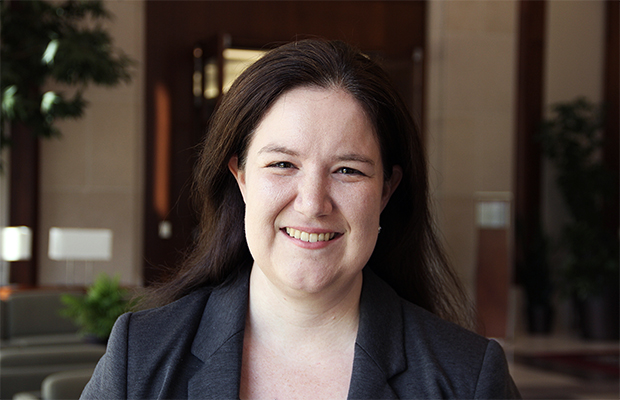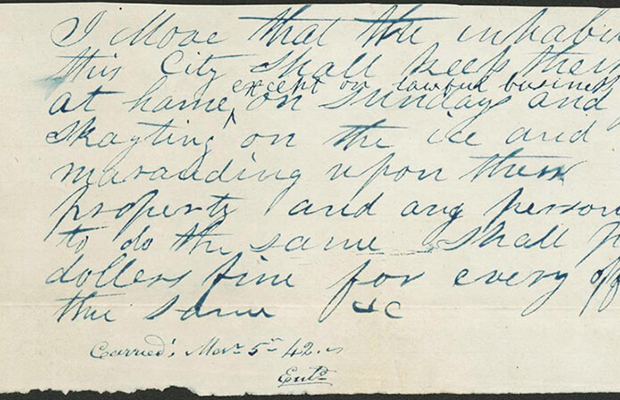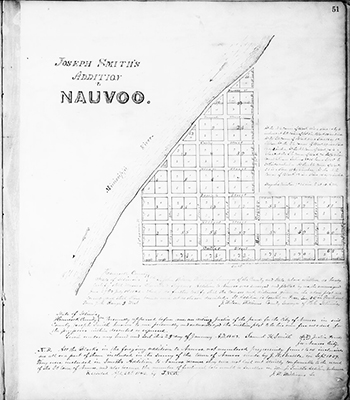Latest Volume of The Joseph Smith Papers Portrays a Different Side of Joseph Smith
Contributed By Trent Toone, Deseret News staff writer

Alex D. Smith, an editor with the Joseph Smith Papers Project, shows a document from Documents, Volume 9: December 1841–April 1842. Photo by Trent Toone, Deseret News.
Article Highlights
- The contents of Documents, Volume 9, demonstrate an organizational time for the Church, as well as the breadth of Joseph Smith’s personal activities.
“[The documents in The Joseph Smith Papers volume will] provide what we hope will be enough context to really come to know who Joseph Smith was, not only as a leader of the Church and the people but as a man.” —Alex D. Smith, editor
Related Links
Joseph Smith held many roles during the Nauvoo era—Church President, mayor, judge, and editor, among others.
A letter the Latter-day Saint prophet wrote to convert Edward Hunter on January 5, 1842, reveals a possibly unexpected role that brought Joseph Smith great joy: store clerk.
In the letter, Joseph tells Hunter about the opening of his new general store.
“The store has been filled to overflowing all day, and I have stood behind the counter dealing out goods as steady as any clerk you ever saw,” Joseph Smith wrote, “to oblige those who were compelled to go without their usual Christmas and New Year dinners for the want of a little sugar, molasses, raisins, etc., etc.—and to please myself also, for I love to wait upon the Saints, and be a servant to all hoping that I may be exalted in the due time of the Lord” (punctuation and spelling standardized).
The Edward Hunter letter, which offers insight into Joseph’s tender nature and warm feelings toward the Saints, is one of more than 100 documents featured in the new Joseph Smith Papers book, Documents, Volume 9: December 1841–April 1842, set to be released on October 8.
Christian K. Heimburger, one of the volume editors for Documents, Volume 9, said for him the letter represents Joseph’s character.
“We know Joseph doesn’t spend a lot of time behind the counter,” Heimburger said. “This may be the only time that we know for sure, but the enthusiasm is tangible. And I think the opening of the store represents a new period in Nauvoo.”
The contents of Documents, Volume 9 demonstrate a productive, “organizational” time for The Church of Jesus Christ of Latter-day Saints, as well as the breadth of Joseph’s personal activities, said Alex D. Smith, an editor of Documents, Volume 9.
Smith spoke at a public lecture titled “Joseph Smith, the Leader” at the Assembly Hall in Salt Lake City on September 26. The lecture explored the many roles Joseph held in Nauvoo in 1842 and possible motivations for his involvement. Smith was joined by Elizabeth A. Kuehn, an editor for Documents, Volume 10, which is scheduled for release in 2020.
In 1842, two years before his death, not only was Joseph Smith engaged in Church, business, and family activities, but the Prophet also organized the Relief Society and set up a Freemasonry lodge. He served as mayor and judge of the city of Nauvoo and editor of Times and Seasons.
Some may wonder why Joseph Smith held so much power and control in Nauvoo, but the evidence provided in these documents illustrates a different story and dimension to his leadership style, Smith said.
“We can look at every role that he plays, every leadership responsibility he takes on, every authority and power he yields . . . and find evidence of how he is trying to protect, how he is trying to serve, how he is trying to care for his people,” Smith said.

Graphic by Church News.
For example, Joseph Smith’s decision to become editor of Times and Seasons, the Church’s newspaper at the time, was based on the need to unify messaging and create “an official communication arm of the Church,” Smith said. He did it because he cared about the members.
“Joseph Smith’s activities become an overarching theme of this time period,” it says in the volume’s introduction. “Joseph Smith remained in Nauvoo, hardly venturing outside the city. But it was a period of intense activity. . . . The documents in this volume are vital to understanding Joseph Smith’s life and the Church’s growth and development during this period.”
Documents, Volume 9 features 102 documents, including:
- 53 letters to or from Joseph Smith.
- 14 business or legal documents.
- 10 discourses.
- 8 documents related to Joseph Smith’s role with the Times and Seasons newspaper.
- 4 revelations.
- 4 meeting minutes.
- 9 miscellaneous documents.
“Letters make up half of the documents that appear in Documents, Volume 9,“ Heimburger said. “These letters kind of reflect the nature of what’s going on in Joseph’s life at the time—Joseph as the Prophet, Joseph as trustee in trust of the Church (a lot of the letters relate to land transactions), as well as correspondence with missionaries.”

A letter written by Parley P. Pratt from his mission in England to Joseph Smith is one of the featured documents in the newest Joseph Smith Papers volume, Documents, Volume 9. Photo courtesy of the Joseph Smith Papers Project.
Readers will be interested to see a document titled “Church History,” dated March 1, 1842, but more commonly known as the “Wentworth letter.”
In response to a request from a newspaper editor named John Wentworth, Joseph Smith published a narrative history of the Church—including a description of the First Vision, the well-known “No unhallowed hand” quote, and a series of statements later known as the 13 Articles of Faith—in the March 1 issue of the Times and Seasons.
“Joseph had previously published manuscripts that chronicle the history of the Church, but this is really the first time that he publishes this information in his own words for Church members to read,” Heimburger said. “We think that’s a pretty exciting document.”
Another noteworthy document in Documents, Volume 9 is the floor plan of Joseph Smith’s two-story brick store. More than just a place of business, the store filled a variety of purposes, including private office, Relief Society and Masonic meeting place, and later place for performing temple ordinances.

Joseph Smith’s brick store, circa 1886, in Nauvoo, Illinois. Photo courtesy of the Joseph Smith Papers Project.
“The store serves as the geographical focal point of our volume,” Heimburger said.
Readers will also learn about the organization of the Female Relief Society of Nauvoo, which occurred on March 17, 1842. Joseph Smith met with 20 women, including his wife Emma Smith, in the upper room of the Nauvoo store and organized the society under the priesthood. The purposes of the organization were to care for the poor, encourage moral reform, and strengthen spirituality, Kuehn explained during the lecture on September 26. The women who joined had to be worthy of membership.
From March to August 1842, Joseph Smith spoke at six meetings of the Female Relief Society of Nauvoo, and his sermons are featured in Documents, Volume 9 and the forthcoming Documents, Volume 10. In his sermons, Joseph Smith emphasized charity, unity, and the priesthood, Kuehn said.
However, he never assumed a leadership role in the organization or made organizational decisions, Smith pointed out.
During the lecture, Smith highlighted the timing between the organization of the Relief Society; Joseph Smith’s decision to join the Freemasons two days before, on March 15; and the reception of the endowment, which occurred in early May. Masonry and the Female Relief Society of Nauvoo prepared the Saints for the endowment, Smith said.
“That’s one of the things that we see in this volume that’s coming out, is the relationship between these [events],” he said. “Because all of Joseph Smith’s documents in these books are presented chronologically, you’re going to see one after the other, right in a row.”
While a lot of books and articles have been written on Joseph Smith, the documents readers find in the new volumes will help answer the question of why he was so involved in Nauvoo and the development of the Church at this time, Smith said.
“They provide what we hope will be enough context to really come to know who Joseph Smith was, not only as a leader of the Church and the people but as a man,” he added.

Alex D. Smith, left, an editor with the Joseph Smith Papers Project, speaks to reporters and bloggers about Documents, Volume 9: December 1841–April 1842. Photo by Trent Toone, Deseret News.

Alex D. Smith, an editor with the Joseph Smith Papers Project, points to a slide while discussing Documents, Volume 9: December 1841–April 1842. Photo by Trent Toone, Deseret News.

Christian K. Heimburger, left, an editor with the Joseph Smith Papers Project, speaks with a blogger about Documents, Volume 9: December 1841–April 1842. Photo by Trent Toone, Deseret News.

Christopher J. Blythe, one of the editors who worked on Documents, Volume 9: December 1841–April 1842, speaks to reporters about some of the documents in the new volume. Photo by Trent Toone, Deseret News.

Among the letters featured in the newest Joseph Smith Papers volume are several items of correspondence between the Prophet and a Pennsylvania convert named Edward Hunter. Photo courtesy of the Joseph Smith Papers Project.

Elizabeth A. Kuehn, an editor for Documents, Volume 10, speaks during a lecture on Joseph Smith’s roles in Nauvoo in 1842 on Thursday, September 26, at the Assembly Hall in Salt Lake City. Photo by Sydney Walker.

Alex D. Smith, an editor for Documents, Volume 9, speaks during a lecture on Joseph Smith’s roles in Nauvoo in 1842 on Thursday, September 26, at the Assembly Hall in Salt Lake City. Photo by Sydney Walker.

Alex D. Smith is a historian and documentary editor for the Joseph Smith Papers Project. He is a volume editor for Documents, Volume 9. Photo courtesy of the Joseph Smith Papers Project.

Elizabeth A. Kuehn is a historian and documentary editor for the Joseph Smith Papers Project. She is an editor for Documents, Volume 10. Photo courtesy of the Joseph Smith Papers Project.

This Nauvoo City Council motion prohibits children from running loose through the city on Sundays and from “marauding upon their neighbors property.” It was written in Joseph Smith’s handwriting. Photo courtesy of the Joseph Smith Papers Project.

Fascimile 2 from the Book of Abraham is one of the featured documents in the newest Joseph Smith Papers volume, Documents, Volume 9. Photo courtesy of the Joseph Smith Papers Project.

An 1842 plat map of Nauvoo is one of the featured documents in the newest Joseph Smith Papers volume, Documents, Volume 9. Photo courtesy of the Joseph Smith Papers Project.

David Hyrum Smith, son of Emma and Joseph Smith, painted this Nauvoo, Illinois, scene sometime before 1869. It’s titled Bend in the River and is featured in Documents, Volume 9. Photo courtesy of the Joseph Smith Papers Project.
